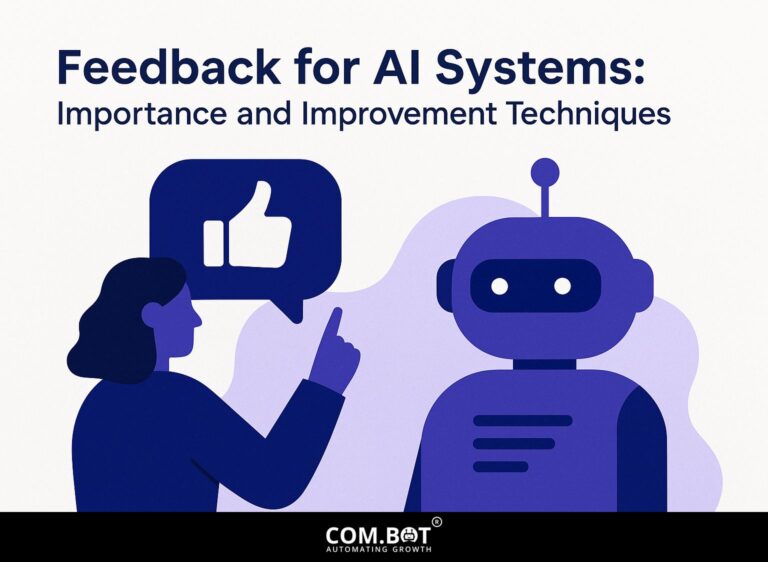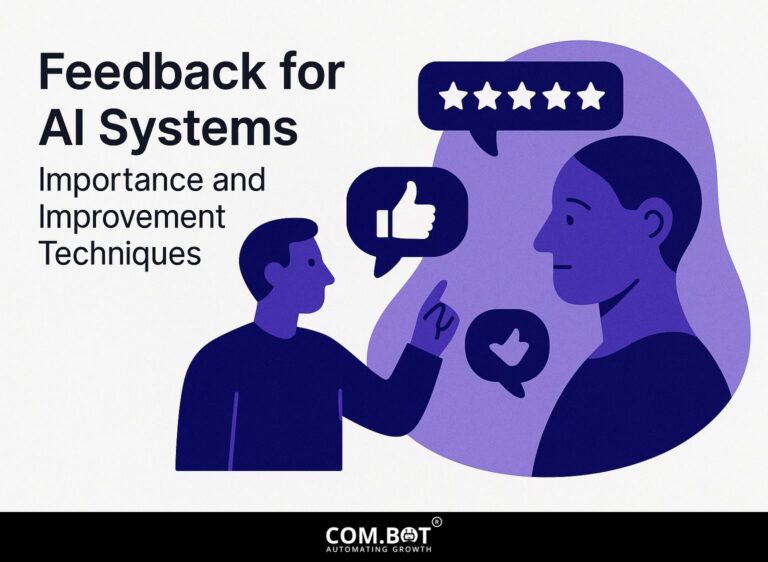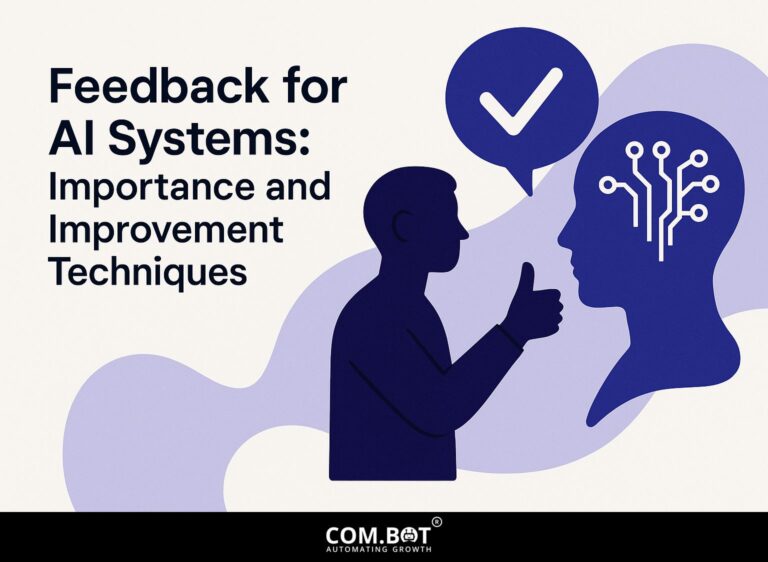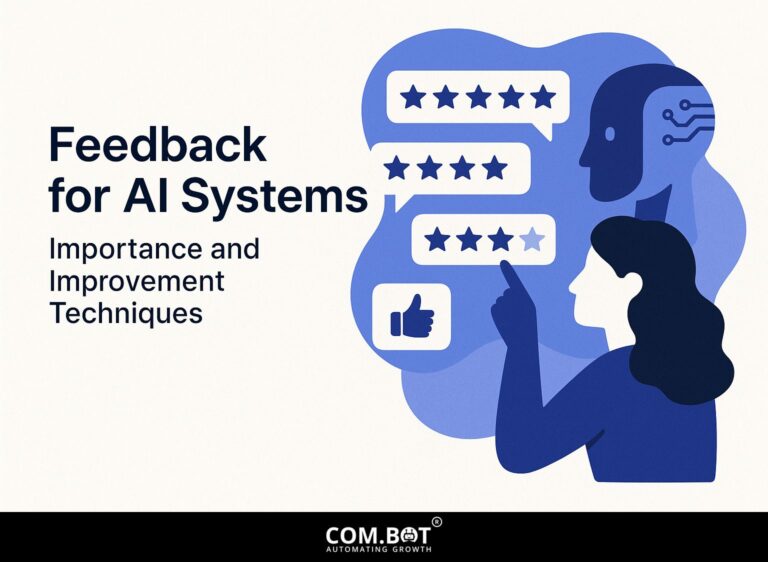Feedback for AI Systems: Importance and Improvement Techniques
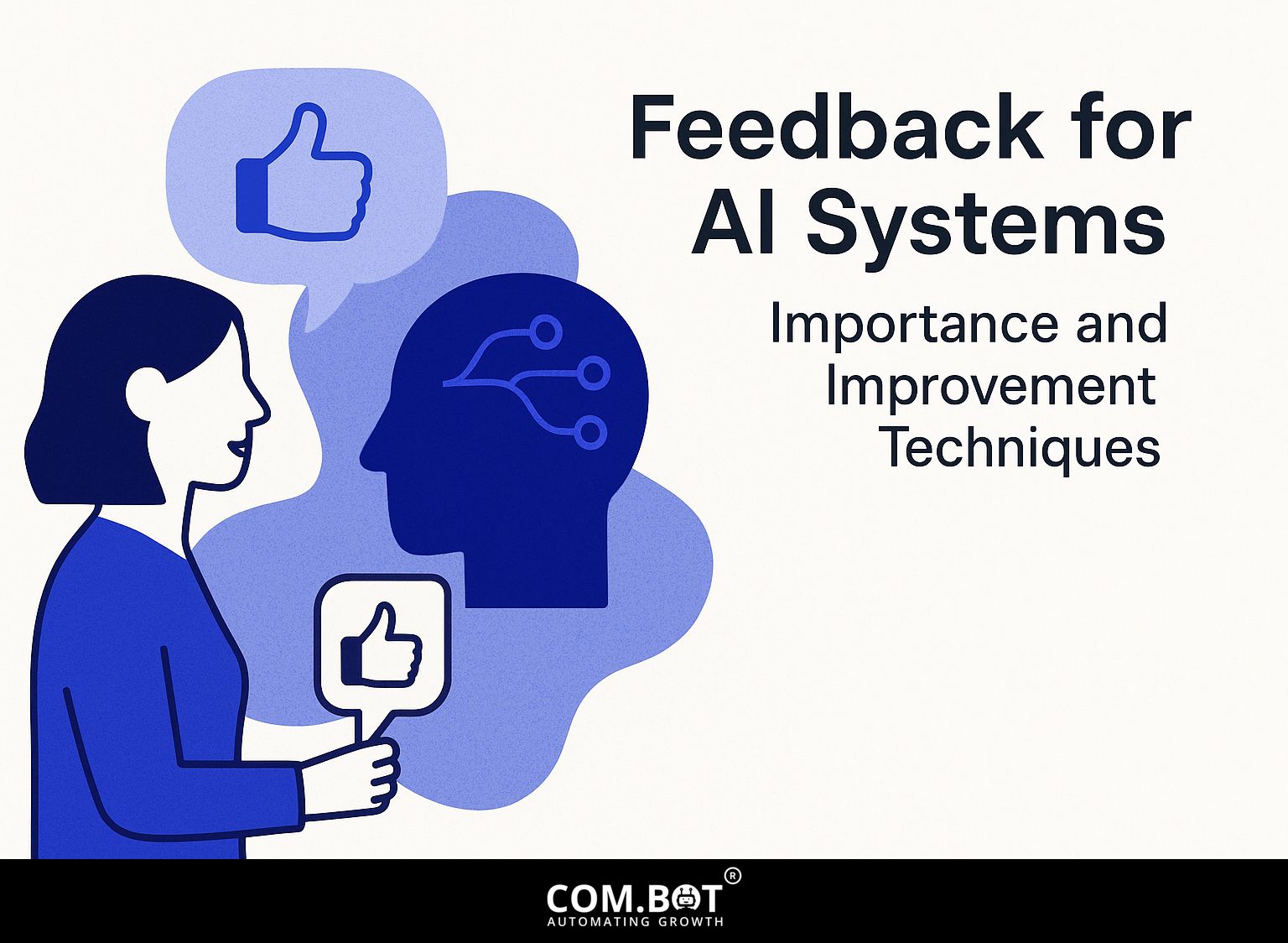
As artificial intelligence evolves rapidly, human involvement is essential for maximizing the benefits of AI systems. As machine learning and reinforcement learning methods improve, it is important to grasp the role of feedback. This article looks at how using human knowledge can make AI more accurate, make user interactions better, and help with ongoing learning. Find useful methods for gathering opinions and see how to set up processes that encourage new ideas in AI projects.
Key Takeaways:
- 1 Importance of Feedback
- 2 Types of Feedback Mechanisms
- 3 Techniques for Collecting Feedback
- 4 Implementing Feedback Loops
- 5 AI Feedback System Metrics
- 6 Challenges in Feedback Implementation
- 7 Frequently Asked Questions
- 7.1 What is the importance of feedback for AI systems?
- 7.2 How does feedback improve AI systems?
- 7.3 What are some techniques for improving feedback in AI systems?
- 7.4 Why is continuous feedback important for AI systems?
- 7.5 How can feedback be collected for AI systems?
- 7.6 What are the benefits of incorporating feedback into AI systems?
Definition of Feedback
Feedback is the information given to AI systems about how they are performing, helping them make better decisions.
Successful feedback mechanisms often include real-time monitoring, which allows systems to adjust their actions based on immediate results.
For instance, autonomous vehicles use sensors to detect obstacles and adjust their routing in real-time, enhancing safety and efficiency. In recommendation systems, user feedback helps make future suggestions better.
Tools like TensorBoard can visualize feedback data during model training, helping engineers understand performance and make informed adjustments. Implementing these systems can significantly improve the overall reliability of AI applications.
Role of Feedback in AI Development
Feedback is essential in AI development. It influences how models learn and improves them for users through ongoing adjustments.
There are two primary types of feedback used during this process: supervised and unsupervised.
Supervised feedback involves human annotations where users label data, ensuring the model learns from specific examples. In contrast, unsupervised feedback allows the model to fine-tune its outputs based on patterns it identifies independently.
Research shows that using feedback can improve model accuracy by up to 30%. By carefully employing both approaches, developers can build strong AI systems that consistently improve and match user requirements more effectively. Related insight: Feedback for AI Systems: Importance and Improvement Techniques
Importance of Feedback
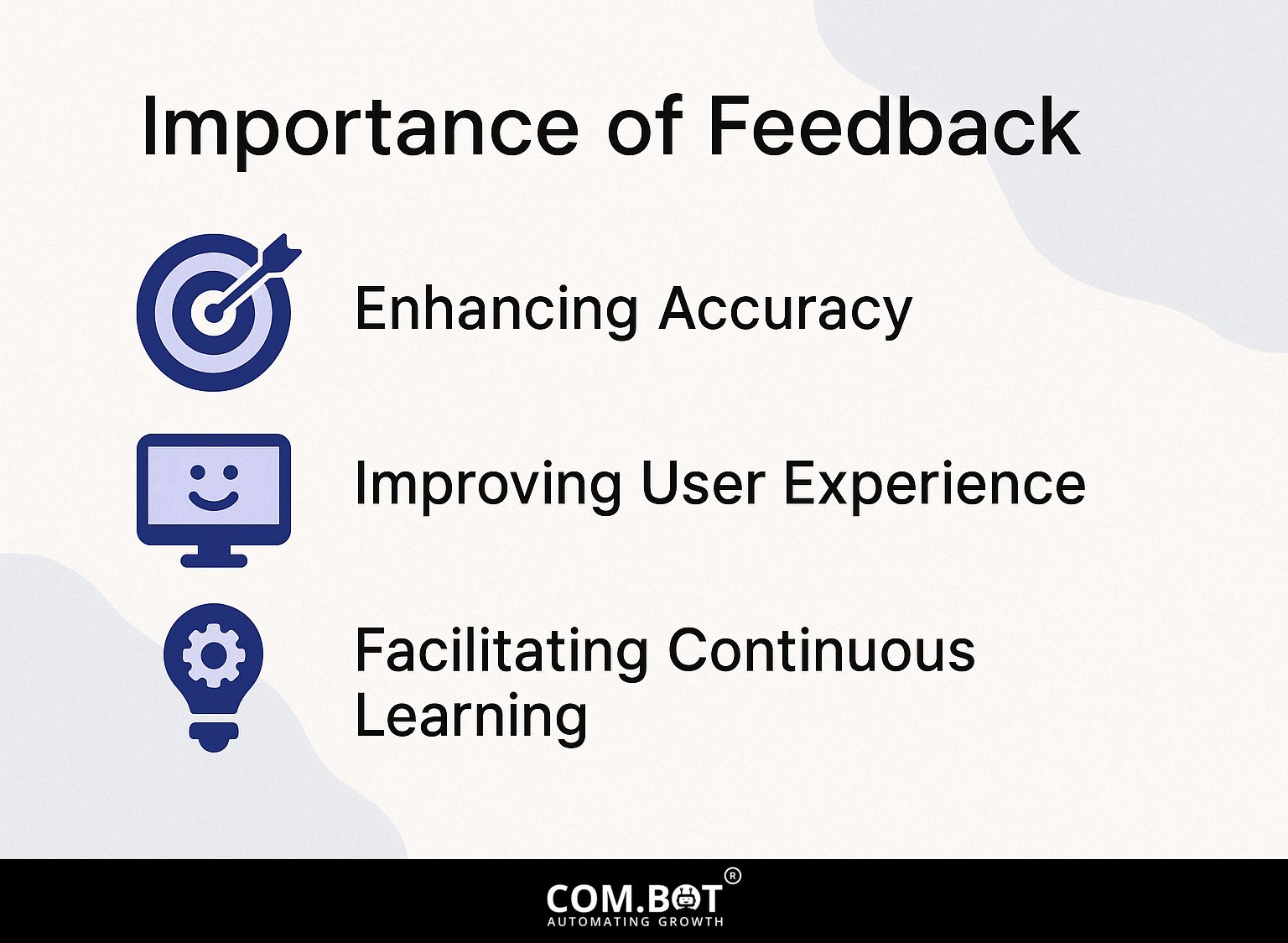
Feedback in AI systems is important because it improves accuracy, makes users happy, and supports continuous learning. See also: our comprehensive guide on Feedback for AI Systems: Importance and Improvement Techniques, which delves deeper into these aspects.
Enhancing Accuracy
Feedback systems can improve the accuracy of AI models by up to 30% through ongoing data-based changes and analysis of performance metrics.
To implement effective feedback, tools like Label Studio can be instrumental. It allows users to annotate data, ensuring that AI models learn from real-world inputs.
By setting up a structured feedback process, you can find and fix model errors methodically. Using user feedback from surveys or UX testing helps improve algorithms more.
Regularly updating your datasets and retraining models based on this feedback will improve accuracy and flexibility in your AI applications.
Improving User Experience
Setting up good feedback methods can increase user satisfaction by 40% by ensuring AI systems change based on what people like.
Getting feedback in real-time is essential for tools like UserVoice and Feedbackify, which gather user opinions immediately.
For instance, UserVoice allows users to submit suggestions that can be voted on, enabling developers to prioritize updates based on community interest. Platforms like Zendesk collect customer feedback to make AI systems better at managing tickets, resulting in quicker and more accurate solutions. This aligns with the principles outlined in our analysis of Feedback for AI Systems: Importance and Improvement Techniques.
By regularly checking this information, AI systems get better and connect more with users, making them feel heard and valued.
Facilitating Continuous Learning
Continuous learning in AI systems depends largely on feedback loops, allowing models to change and get better over time through repeated learning.
Amazon uses customer feedback a lot to improve product recommendations. By studying how users behave and what they say in reviews, the AI can change its algorithms to improve accuracy.
Similarly, Netflix uses viewer ratings and engagement metrics to improve content suggestions, ensuring they align with user preferences.
Using organized feedback methods is important; this might include surveys, direct comments from users, or reviewing usage data. These observations help AI systems change and get better, creating experiences that fit each person’s needs.
Types of Feedback Mechanisms
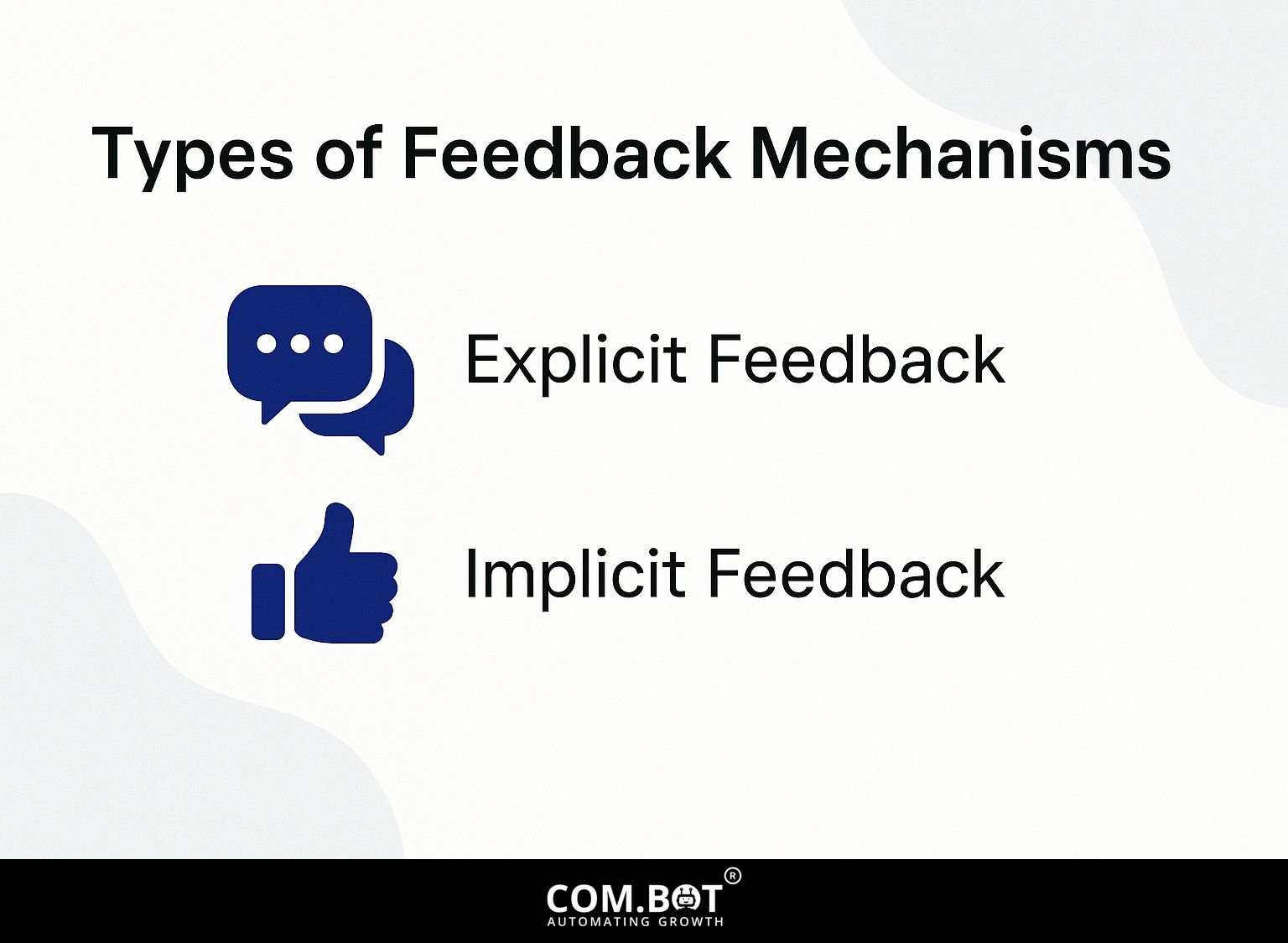
Knowing the various kinds of feedback methods is important for improving AI systems, as they control how user actions are handled. I recently came across this detailed discussion on feedback techniques for AI systems that expands on their significance and ways to enhance them.
Explicit Feedback
Explicit feedback, such as user ratings or surveys, directly informs AI systems about user preferences, enhancing data quality.
To effectively gather this feedback, consider using tools like Google Forms or SurveyMonkey. These platforms enable you to make surveys specific to different parts of your service, like user satisfaction or requests for new features.
Aim for a concise survey of 5-10 questions, which typically garners a response rate of 30-50% if shared after a meaningful interaction with your service.
Offering discounts or chances to win prizes can increase involvement, helping you gather useful information for ongoing improvement.
Implicit Feedback
Implicit feedback looks at what users do and how they interact to give useful information without asking them directly.
To collect this feedback well, use tools like Google Analytics to monitor user activity data such as click rates and time spent on the site.
Hotjar allows you to visualize user behavior through heatmaps and session recordings, which can highlight how users interact with your features. For example, by setting up conversion funnels in Google Analytics, you can see at which stages users drop off, enabling targeted improvements.
Using these methods helps you make your product better with actual user data, improving the user experience without needing surveys.
Techniques for Collecting Feedback
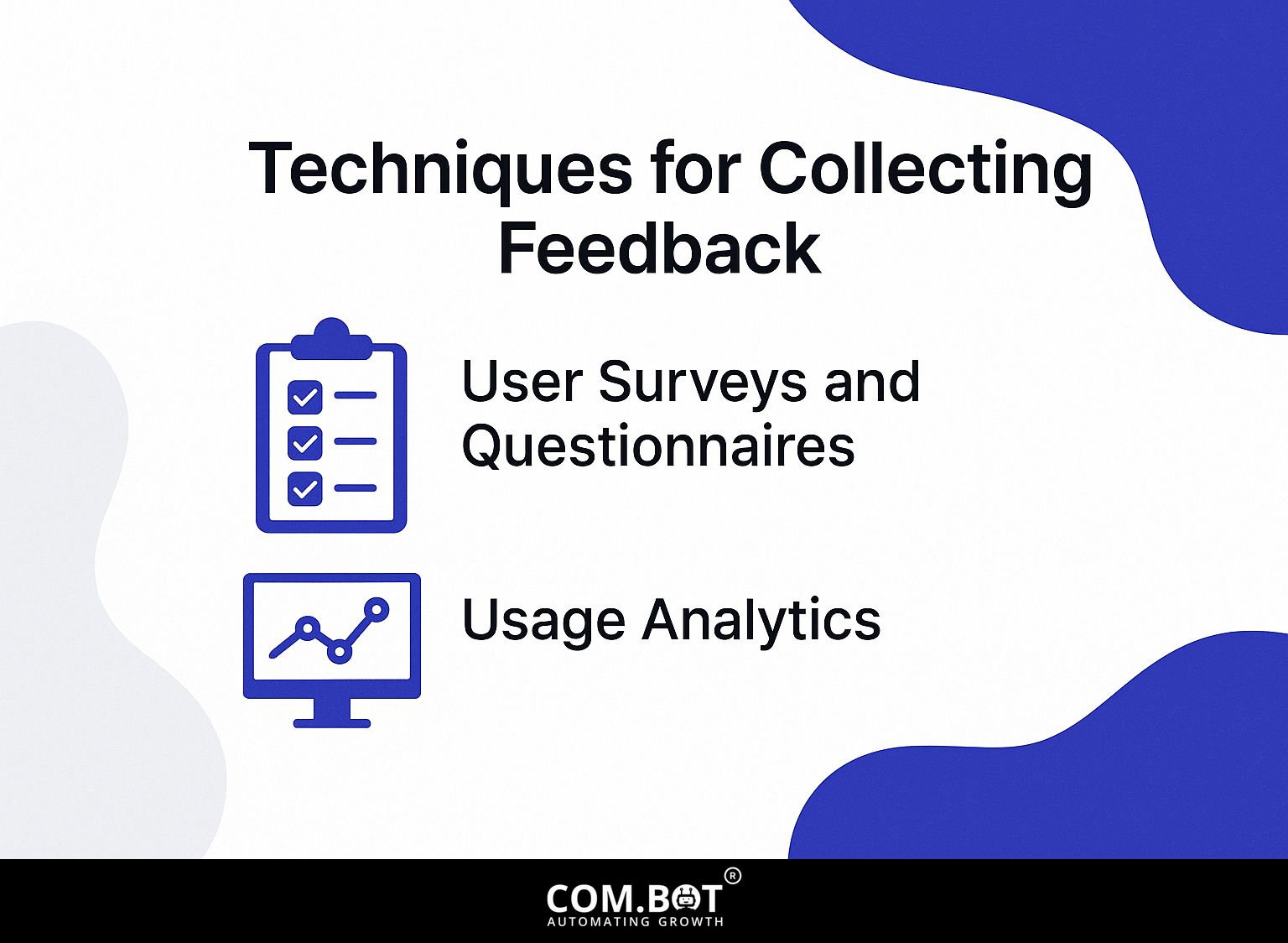
Collecting feedback well is important to learn about what users need and to make AI work better.
User Surveys and Questionnaires
User surveys and questionnaires can provide helpful information, often getting a 20-30% response rate when planned well.
To maximize this rate, consider using tools like SurveyMonkey or Google Forms, which offer user-friendly interfaces.
Start by including both closed questions, such as rating scales, and open-ended questions to gather qualitative feedback. Aim for clarity and simplicity in wording to avoid confusion.
Offering discounts or prize draws can greatly increase participation.
Testing your survey with a small group first makes sure people understand the questions, improving the survey and increasing responses.
Usage Analytics
Using tools that track how people use your site, like Google Analytics, can give a lot of helpful information about their activities.
To effectively set up and interpret usage analytics, start by defining key performance metrics such as user engagement, session duration, and bounce rate.
For example, tracking user engagement can be accomplished through Google Analytics’ Events feature, allowing you to monitor specific interactions like clicks on a call-to-action.
Use tools like Hotjar or Crazy Egg to see where people click most on your site.
Regularly checking these metrics allows you to change your strategies, so you can make users happier and make the site work better.
Implementing Feedback Loops
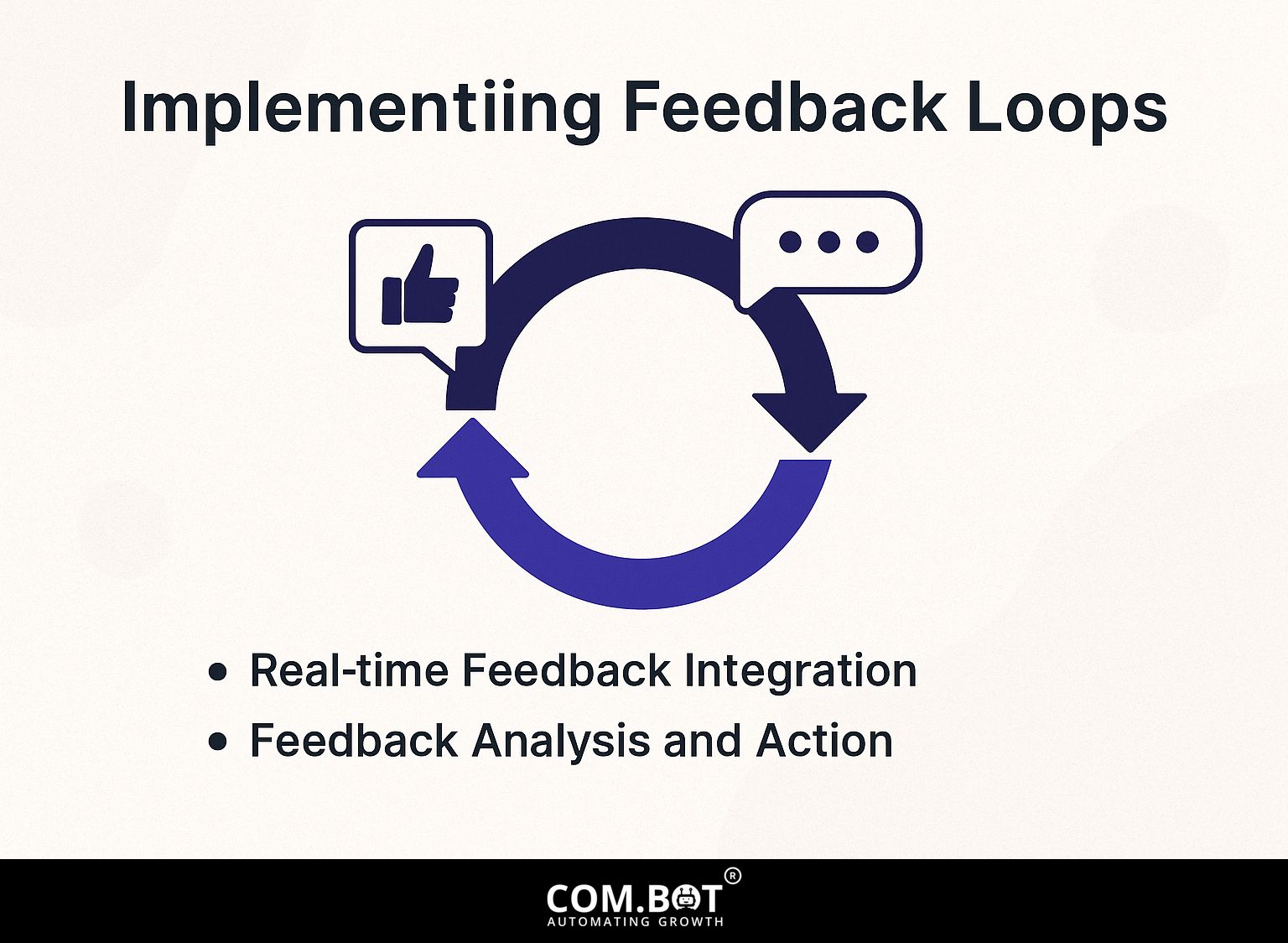
Establishing feedback loops is important for developing AI systems that improve through user input and data trends.
Real-time Feedback Integration
Real-time feedback integration lets AI systems change immediately based on user actions, greatly improving user experience.
To make the process easier, use tools like Zapier to gather feedback from platforms like SurveyMonkey or Typeform automatically. For example, if a user gives a low rating to an AI assistant’s response, Zapier can update your system so the AI can quickly make its suggestion logic better.
Use Google Sheets to monitor feedback patterns, enabling continuous review and changes. Set up alerts for low satisfaction scores so your team can proactively address issues, ensuring a continuously improving user interface.
Feedback Analysis and Action
Looking closely at feedback can give helpful details, aiding in better performance checks and guiding decisions.
- Start by collecting feedback through surveys using tools like SurveyMonkey or Google Forms.
- After collecting your data, use Tableau to make visual displays that help you see patterns more clearly.
- For instance, if customers indicate dissatisfaction with a specific feature, compare this against usage statistics to pinpoint possible causes.
- Turn these observations into practical changes by focusing on the most frequent and impactful feedback.
This organized method can change basic information into important choices that improve how users interact and make processes work better.
AI Feedback System Metrics
AI Feedback System Metrics
The AI Feedback System Metrics report, while currently devoid of detailed datasets, signifies the importance of tracking and analyzing various performance indicators related to AI-driven feedback systems. AI feedback systems play an important role in various situations, giving recommendations and improvements by analyzing how users act and examining data.
The possible measurements for this report cover various aspects:
- User Engagement: Metrics like the number of users, how often they interact, and how long each session lasts can show how effectively the AI system holds user interest and keeps them engaged over time.
- Feedback Accuracy: It is important to check how often the feedback from the AI system matches expert views or user happiness. This can be quantified by accuracy rates, error margins, and user feedback ratings.
- Response Time: The speed at which the AI system processes inputs and generates feedback is essential for user satisfaction. Metrics would include average response time and the percentage of responses delivered within an acceptable timeframe.
- Improvement Over Time: Tracking how the system’s performance improves with more data and feedback can indicate its learning efficiency. Metrics here might include the reduction in error rates and improved user satisfaction scores over time.
- User Demographics: Knowing the different types of users, divided by age, location, and other characteristics, can help adjust feedback systems to better fit various user groups.
- Usage Trends: Looking at when and how often people use the system, including busy times and changes over the year, can improve system performance and resource allocation.
Although the AI Feedback System Metrics The report doesn’t have detailed data right now, but the possible metrics mentioned show the full analysis that could be done to improve and fine-tune AI feedback systems. Effective tracking and improvement of these metrics can lead to more accurate, timely, and user-friendly feedback mechanisms, ultimately driving better user experiences and outcomes across various applications.
Challenges in Feedback Implementation
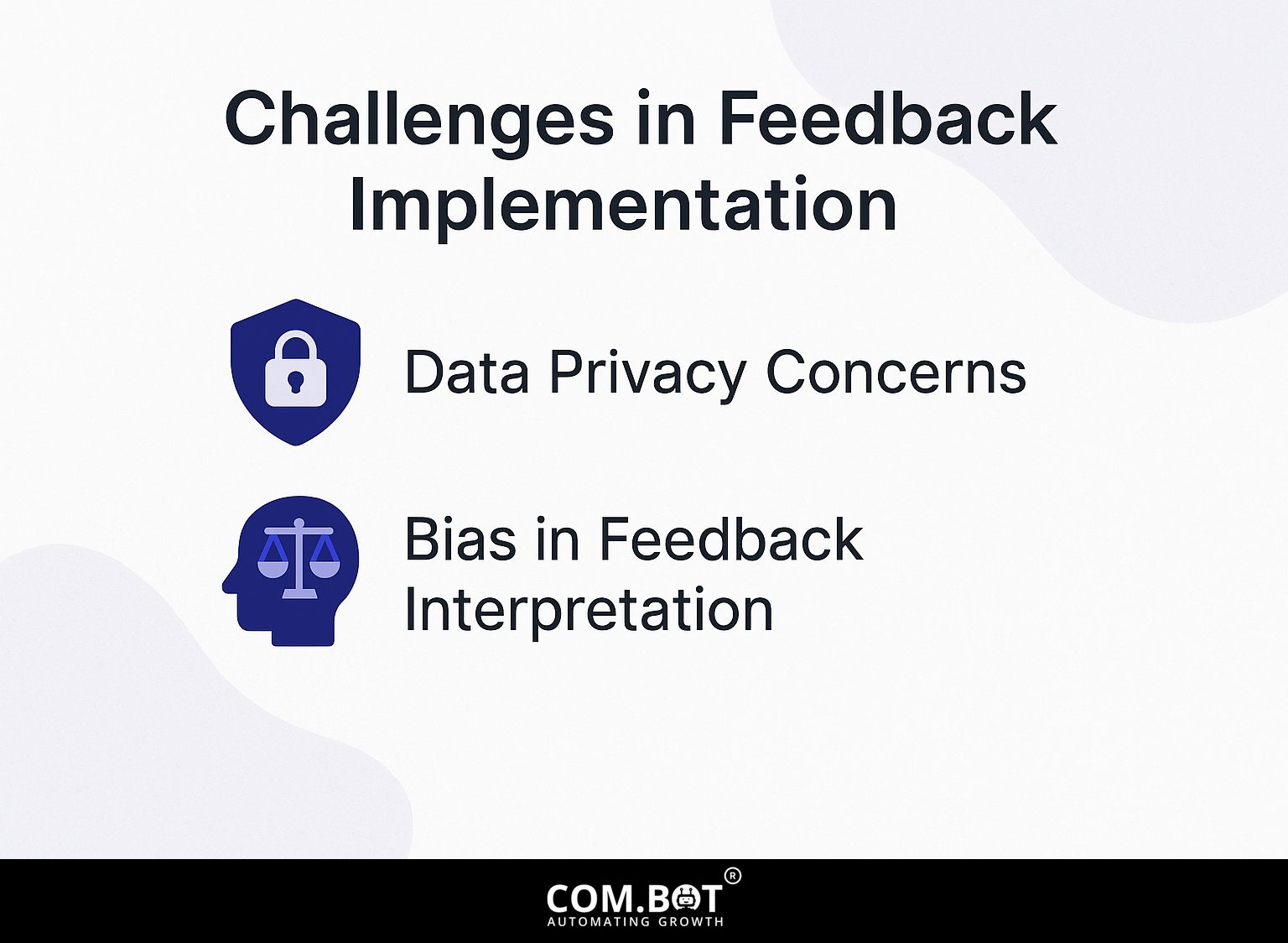
Setting up systems to receive feedback can be hard for several reasons, such as concerns about protecting data and the possibility of misunderstanding information. To effectively navigate these challenges, understanding the importance and techniques for improving feedback in AI systems can be crucial.
Data Privacy Concerns
Data privacy concerns can limit feedback collection, especially with regulations like GDPR affecting how user data is handled.
To follow the rules while collecting opinions, think about using tools like OneTrust. It helps handle user permission with adjustable banners.
Start by clearly outlining what data you collect and its purpose; transparency is key. Integrate an opt-in preference center, allowing users to choose their communication preferences.
Check your data collection methods often to make sure they follow current rules. By following these best practices, you can build trust with your users while still gathering important feedback.
Bias in Feedback Interpretation
Getting feedback wrong can cause mistakes in interpretation, hurting AI performance and lowering user trust if not properly managed.
To reduce these biases, use strategies such as varying data collection methods to gather different viewpoints.
For example, use user surveys, A/B testing, and focus groups to collect detailed feedback. Regularly adjust algorithms to account for feedback loops that may reinforce biases.
Using Google Analytics to monitor how users interact can provide detailed information to guide these changes. By gathering and learning from user feedback, organizations can improve AI reliability and build more user trust.
Frequently Asked Questions
What is the importance of feedback for AI systems?
Feedback is important for AI systems because it helps them learn and handle various situations. It makes AI systems more accurate and efficient, allowing them to perform tasks effectively.
How does feedback improve AI systems?
Feedback gives AI systems important details about how well they are working and helps them change their algorithms as needed. This leads to better decisions and more accurate task performance.
What are some techniques for improving feedback in AI systems?
There are different ways to make feedback in AI systems better, like using human involvement, adding related information, and applying reinforcement learning methods.
Why is continuous feedback important for AI systems?
Ongoing feedback allows AI systems to keep learning, which makes them better at dealing with complicated and unexpected situations. It also helps to identify and correct errors or biases in the system.
How can feedback be collected for AI systems?
Feedback for AI systems can be collected through various methods such as surveys, user testing, monitoring user interactions, and incorporating user preferences and ratings into the system.
What are the benefits of incorporating feedback into AI systems?
Including feedback in AI systems results in better performance, higher user satisfaction, and the ability to adjust to new situations. It also helps to identify areas for improvement and drive innovation in the field of AI.
